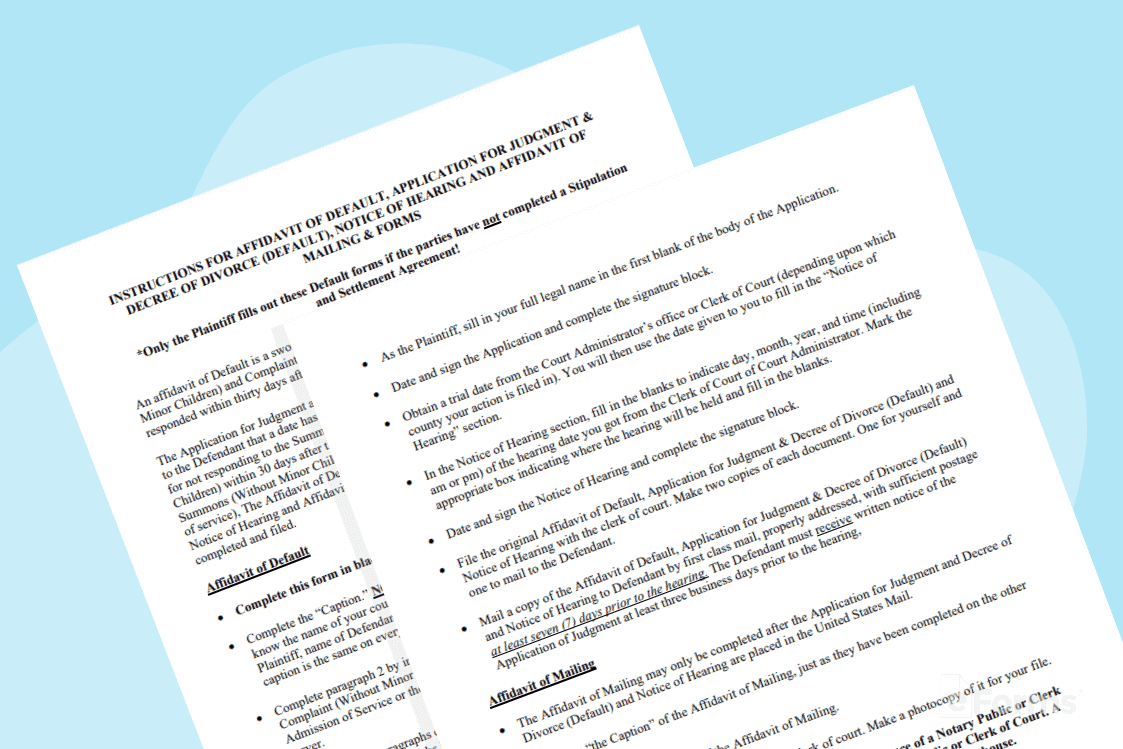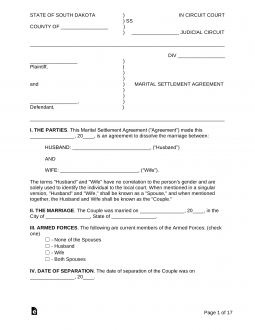Updated August 29, 2023
A South Dakota marital settlement agreement is a divorce tool used by spouses filing for an uncontested divorce to settle matters relating to the marriage’s dissolution. This document covers divorce issues such as alimony, property distribution, child support, child custody, and child visitation. The circuit court also provides a marital settlement agreement document through their website (see Divorce Forms below), which is referred to as a Stipulation and Settlement Agreement. Once completed and filed, the agreement becomes a part of the divorce action and demonstrates to the judge that the parties have indeed come to an understanding with regard to all matters related to their divorce. Signing the settlement agreement does not grant a divorce; the judge must sign a Judgment and Decree of Divorce, and the parties must receive a copy thereof in the mail to finalize the divorce.
Table of Contents |
Divorce Laws
Statutes – Title 25, Chapter 4 (Divorce and Separate Maintenance)
Alimony (§ 25-4-41) – In certain divorce actions, the court will be compelled to order one spouse to make payments to the other in the form of spousal support (alimony) for the duration of their life or for a limited period of time. The court may choose any amount they deem just, having considered the circumstances of the marriage and any other relevant and pertinent factors.
Alimony Calculator – calculators.law
Child Support (§ 25-7-6.1 et seq.) – Child support is determined by combining the monthly incomes of both parents and dividing the payment obligations proportionately between them based on those respective income amounts. A support obligation schedule is provided in § 25-7-6.2 of the South Dakota statutes.
Child Support Calculator – South Dakota Department of Social Services
Division of Property (§ 25-4-44) – When the court is in charge of dividing property between the spouses during a divorce action, they will distribute the property equitably between the parties. This differs from community property law, where the court will divide all assets of the marriage in an even 50/50 split between the spouses.
Grounds for Divorce (§ 25-4-2) – The following is a comprehensive list of the grounds for divorce in the state of South Dakota:
- Adultery
- Extreme cruelty
- Willful desertion
- Willful neglect
- Habitual intemperance
- Conviction of felony
- Irreconcilable differences
Interim Support (§ 25-4-38) – During the proceedings for a divorce action, the court may require one spouse to pay interim support (temporary alimony) to the other spouse.
Residency (§ 24-4-30) – The spouse filing a divorce action (“plaintiff”) must be a resident of South Dakota at the time they file the action. The action may be filed in the county of residence of either the plaintiff or the defendant (non-filing party), with the defendant reserving the right to change the trial to the county where they reside.
Divorce Forms
- Where to File – Circuit Court
- Filing Fee – $95
- How Long Does it Take? Sixty (60) days (minimum)
Uncontested Divorce with No Children:
- Case Filing Statement
- Summons
- Complaint
- Financial Affidavit
- Checklist for Self-Represented Divorce (optional)
- Admission of Service
- Notice of Admission of Service
- Answer
- Stipulation and Settlement Agreement Without Minor Children
- Affidavit of Plaintiff and Defendant as to Jurisdiction and Reason for Divorce
- Judgment and Decree of Divorce
- Notice of Entry of Judgment and Decree of Divorce (provided by Court Clerk)
Default Forms (If Applicable)
- Default Divorce Form Packet
- Affidavit of Defendant’s Military Status
- Judgment and Decree of Divorce (Default)
Uncontested Divorce With Children:
- Case Filing Statement
- Summons
- South Dakota Parenting Guidelines
- Complaint
- Financial Affidavit
- Checklist for Self-Represented Divorce (optional)
- Admission of Service
- Notice and Admission of Service
- Answer
- Stipulation and Settlement Agreement With Minor Children
- Affidavit of Plaintiff and Defendant as to Jurisdiction and Grounds for Divorce
- Judgment and Decree of Divorce
- Notice of Entry of Judgment and Decree of Divorce (provided by Court Clerk)
Default Forms (If Applicable)
- Default Divorce Form Packet
- Affidavit of Defendant’s Military Status
- Judgment and Decree of Divorce (Default)
How to File for Divorce in South Dakota (7 steps)
- Uncontested Divorce
- File Initial Divorce Paperwork
- Serve Defendant
- Defendant’s Answer
- Default (If Applicable)
- Stipulated (Uncontested) Divorce
- Hearing
1. Uncontested Divorce

In uncontested cases, both spouses must agree to all affairs related to the divorce, such as spousal and child support, child custody and visitation, and property division. When it comes to filing for divorce, either party may commence the divorce action by filing the appropriate paperwork. The spouse who files the initial paperwork becomes the “plaintiff” and the other spouse is referred to as the “defendant.” The spouse filing a divorce action must be a resident of South Dakota at the time they file the action. Furthermore, the action may be filed in the county of residence of either the plaintiff or the defendant, with the defendant reserving the right to change the trial to the county where they reside, if they so wish.
2. File Initial Divorce Paperwork

To commence the divorce proceedings, the plaintiff must download and complete the following forms:
Without Children:
- Case Filing Statement
- Summons
- Complaint (notarization required)
- Financial Affidavit (notarization required)
With Children:
- Case Filing Statement
- Summons
- South Dakota Parenting Guidelines
- Complaint (notarization required)
- Financial Affidavit (notarization required)
- For divorces with minor children, the Child Support Calculation must be completed as well.
The Complaint form contains a section above the signature fields that enable either the plaintiff or the defendant to revert to their maiden name once the divorce is finalized. Resuming one’s maiden name during the divorce proceedings is much easier than filing a separate petition at a later date. The plaintiff must file the original documents with the clerk of the Circuit Court in the appropriate county and pay the $95 filing fee.
3. Serve Defendant
- Hand Delivery: If the plaintiff is confident the defendant will accept service of the divorce papers (which is the case in most uncontested divorces), they may hand over the divorce papers to the defendant themselves. They will bring with them an Admission of Service of Summons and Complaint (Without Children | With Children) for the defendant to sign (must be signed in the presence of a notary). The Admission of Service must be filed with the court clerk.
- Mailing: The plaintiff can choose to mail copies of the divorce papers to the defendant, along with a self-addressed envelope and two (2) copies of the Notice and Admission of Service of Summons and Complaint (Without Children | With Children). The plaintiff must sign the Affidavit of Mailing portion of the notice form in the presence of a notary. The defendant must sign the Admission of Service portion of the document (notarization required) and return the document to the plaintiff within twenty (20) days of receiving the paperwork.* All forms must be filed with the court clerk once completed.
- Sheriff / Personal Server: The plaintiff may hire the sheriff’s office or a private process server to serve the divorce papers on the defendant. Sheriff’s and private servers will charge a fee for their services. The plaintiff must provide them with a copy of each document to serve on the defendant. The server will complete a proof of service form (that they will provide) to complete and send to the plaintiff once service is complete. This proof of service must be filed with the court clerk.
*Note: If the defendant does not return the Admission of Service on time, they may be ordered by the court to pay for the cost of personal service, as the plaintiff will have to hire the sheriff’s office or a private process server to complete the service.
4. Defendant’s Answer
5. Default (If Applicable)

The default divorce option is only available in situations where the plaintiff properly served the paperwork on the defendant and the defendant failed to answer within the thirty-day (30) period. However, the plaintiff must wait a total of sixty (60) days from the date they served the defendant to file the default divorce paperwork. After the waiting period, the plaintiff can download and complete the following forms:
Without Children:
- Default Divorce Forms Packet
- Affidavit for Default (notarization required)
- Application for a Judgment and Decree of Divorce
- Notice of Hearing
- Affidavit of Mailing (notarization required)
- Affidavit of Defendant’s Military Status (notarization required)
With Children:
- Default Divorce Forms Packet
- Affidavit for Default (notarization required)
- Application for a Judgment and Decree of Divorce
- Notice of Hearing
- Affidavit of Mailing (notarization required)
- Affidavit of Defendant’s Military Status (notarization required)
These forms must be filed with the court clerk, and copies must be sent to the defendant and received at least three (3) business days before the hearing date. On the day of the hearing, the plaintiff must bring a Judgment and Decree of Divorce (Default) form (Without Children | With Children) to the hearing (only the “caption” should be completed by the plaintiff, the judge will complete the rest). The judge will sign the document and a clerk will complete a Notice of Entry of Judgment and Decree of Divorce. The clerk will send copies of the Notice and Judgment forms to the plaintiff and defendant, finalizing the divorce.


